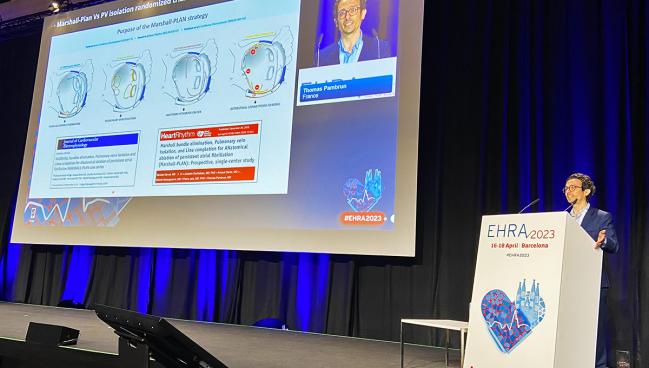‘Marshall Plan’ Ablation Superior to Pulmonary Vein Isolation in Persistent AF
The three-step approach, targeting multiple proarrhythmogenic atrial structures, may cut down on redo ablations.

BARCELONA, Spain—A comprehensive ablation strategy—a three-step approach that systematically targets the anatomical atrial structures known to be proarrhythmogenic—is superior to pulmonary vein isolation (PVI) alone when it comes to the treatment of patients with persistent atrial fibrillation (AF), preliminary data from a new study show.
Presenting the early results this week at the European Heart Rhythm Association (EHRA) 2023 congress, Thomas Pambrun, MD (Centre Hospitalier Universitaire de Bordeaux, France), reported that 84% of patients treated with the comprehensive ablation strategy, known as the “Marshall Plan,” were free from atrial fibrillation or atrial tachycardia (AT) at 10 months compared with 69% of patients treated with conventional PVI.
While the Marshall Plan ablation takes longer to perform, Pambrun said the advantage is that fewer people will return to the lab for a repeat procedure.
“Is it overtreatment, especially since we have quite good results with pulmonary vein isolation?” asked Pambrun, noting the success rate with PVI ranges from 65% to 70% at 1 year. With the more-comprehensive lesion set, however, physicians can prevent roughly 15 out of every 100 patients from needing a second ablation. More redo procedures with traditional PVI could also be considered overtreatment, said Pambrun, noting that these carry risks of stroke, tamponade, and other adverse events.
“I think [with] the Marshall Plan first, it’s 1 hour longer, and for those 15 patients, you prevent a second procedure,” he told TCTMD.
Targets Proarrhythmogenic Anatomy
Back in 1948, the original Marshall Plan referred to the financial assistance provided by the US to help Western European countries get back on their feet economically, keeping Soviet Union expansionism at bay. Marshall Plan ablation aims to spur a recovery of a different sort, staving off recurrent atrial arrhythmias by targeting multiple proarrhythmogenic atrial structures: PVI, an ethanol infusion of the vein of Marshall, and a linear ablation set to block the anatomical isthmuses to the pulmonary veins (dome, mitral, and cavotricuspid isthmus lines). These isthmuses, said Pambrun, are known reentrant circuits for AT, but are not systematically targeted during routine PVI.
The additional lesions, stressed Pambrun, “do not impact the natural activation of the atria.”
To compare the two strategies, researchers randomized 120 patients with symptomatic, persistent AF to PVI alone or the Marshall Plan ablation. The full lesion set was performed in 88% of patients treated with the Marshall Plan and 98% of those undergoing PVI alone.
In the intention-to-treat analysis, the recurrence of AF/AT > 30 seconds after an average follow-up of 10 months was significantly higher in the PVI alone group (18 vs 9 patients; P = 0.038).
When investigators performed the redo procedure—nine patients in the PVI-only group and six patients in Marshall Plan group had a second ablation—they found that the pulmonary veins were completely isolated in all patients randomized to PVI. “This is a very important point, because it means we have no more gaps to close,” said Pambrun. “There is no room for any improvement in these patients.”
Among the six patients in the Marshall Plan group who had a redo procedure, all had identifiable spaces in the lesion set, “which means that we can still have an improvement in these patients after we close the gaps,” he noted.
Not Easy, but Learnable
Although the trial is not yet completed—roughly one-quarter of patients are still being followed—the results are “pretty encouraging,” said Pambrun. In terms of complications, there was one massive groin hematoma in a patient ablated with the comprehensive approach.
“The whole point of this strategy is that it’s clear,” he told TCTMD. “I’m not saying it’s easy, but it’s clear. This type of clear endpoint—blocking the [isthmus] lines—allows you to improve very fast, because you can identify the peak force when you have a line that is not blocked. I think we have better results now with this technique than when we started 4 years ago because we have come to identify some reasons for our gaps, especially in the mitral line and roof line.”
Gerhard Hindricks, MD (Leipzig Heart Center, Germany), the discussant following the late-breaking presentation, said the trial gets at the root of an important question: what can be done in addition to PVI to improve outcomes in patients with persistent AF? Different strategies, whether those include additional lesion sets or substrate modification, have been shown to be effective, but none of those have been tested in a randomized trial, said Hindricks.
The downside of the present strategy is that it includes multiple steps, said Hindricks, which makes it impossible to tease out which supplemental lesion set is responsible for reducing AF/AT recurrence. Instead, operators must take the strategy as a whole: “If you do the Marshall Plan, you can expect an improved outcome,” said Hindricks, adding that cardiologists will be eagerly awaiting the final results.
Michael O’Riordan is the Managing Editor for TCTMD. He completed his undergraduate degrees at Queen’s University in Kingston, ON, and…
Read Full BioSources
Pambrun T. Marshall Plan versus pulmonary vein isolation: preliminary results of the monocentric randomized trial. Presented at EHRA 2023. April 18, 2023. Barcelona, Spain.





Comments